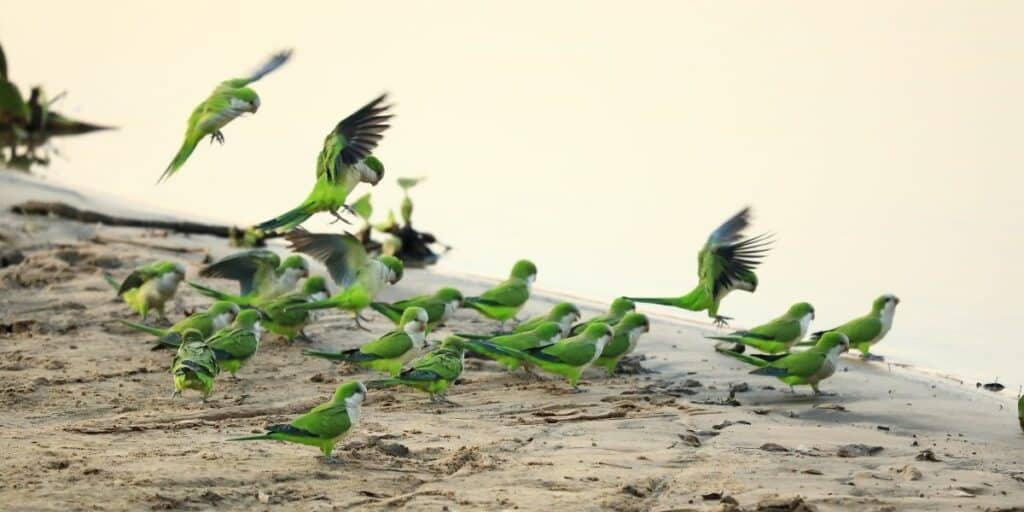They prefer the green seedheads of grass and secondarily the dried seed. They will also eat vegetation too including tender roots, shoots, plant buds, and eucalypt leaves.
You might think the life of a caged parakeet is positively pampered compared to its wild counterpart, but, as you’ll find, wild parakeets are living the good life too!
In this article, we answer the question “what do wild parakeets eat?” and see if some useful insights can be gained for providing your pet parakeet with a more authentic diet.
Parakeets are a diverse family of small parrots with a characteristic slender build and long tails. There are over 100 different species, but the Australian budgerigar is probably the most well-known as it is widely kept as a pet in North American and European homes.
Table of Contents
The foraged diet of a grassland parakeet
This characterful creature makes its home in large nomadic flocks on expansive Australian grasslands and woodlands. The movements of these vast communities of parakeet are determined by the availability of food and the weather.

What wild parakeets eat
Its affinity for a grassland diet earns it the name grass parakeet. These foraging grassland budgies roam over hundreds of miles to feed primarily on grass seed as well as wheat grains and when in coastal areas, spinifex, a perennial coastal plant. They prefer the green seedheads of grass and secondarily the dried seed. They will also eat vegetation too including tender roots, shoots, plant buds, and eucalypt leaves.
You may think of budgies sitting high up in a tree, but actually, these birds are ground feeders. They will daily leave their treetop roosts and fly up to 50 kilometers to the seeded grasses where they descend and forage.
They spend most of their time systematically going through the grasses, fossicking for food. As group feeders, parakeet hoards will comb the grasslands en masse, taking advantage of being able to alert one another to danger or the availability of food.
They are most active in the early to mid-morning and late afternoon, seeking shelter in the trees during the hottest part of the day and returning to roost in the evenings.
Whether captive or wild Parakeets need to lead an active life and forage for their food
As you can see, the life of a pet parakeet is drastically removed from its wild relatives. This has led many animal experts to consider deeply how the natural instincts of this species can be retained and exercised in the domestic setting.
Captive breeding and the supply of food without foraging go directly against the natural instincts of the parakeet. It is now increasingly recognized that these birds need to be handled and cared for in a many that are as close to nature as possible.
In particular, this includes the acknowledgment that parakeets are ground-feeding birds.
How pet parakeets are fed predisposes them to become overweight
Breeders have found that the combination of small cages and abundant bowls of fatty seed is a recipe for disaster when it comes to parakeet weight and overall health.
It completely goes against the natural inclinations of the birds who soon find themselves gorging on oats and calorie-dense grains that do not require even the effort of dehusking to eat.
Even the use of a wire floor at the bottom of the cage removes all seed husks and debris so that the budgie does not have to forage to get to the seed.
This is the budgie equivalent of a Big Mac and fries continually and with no effort to eat these nimble birds are soon waddling.
With budgies it’s not so much what you feed them but how!
One breeder who recognized these problems wanted to make changes to how he cared for his birds bringing their feeding into line with the foraging and fossicking of wild parakeets. Here are the key points of what he did to provide a natural forage-feeding experience to his parakeets that you can reproduce too:
- Boost the space: Flying from the tree to ground feed is a big part of the activity of wild parakeets. Recreate this activity in your pet by having a cage with as much vertical height as possible with the food placed on the ground.
- Let the parakeets climb up and down to access their food. Aside from perches, offer your parakeets ladders that they can climb up and down to stay active while they access their food.
- Layer some timothy hay on the bottom of the cage to be used as a base of a forage. This, in a small way, recreates It should be changed at regular intervals as the budgies will chew this down.
- The seed is set in deep dishes amongst the hay. By nesting the food dishes among the hay, the budgies will forage, working for their meal.
- Leftovers in the seed trays were dumped on the floor to encourage the budgies to forage for any remaining seed. This can be done in place of food for a whole day at regular intervals so the budgies will forage for their meal entirely.
Rounding up
Thinking about the wild diet and foraging behaviors of parakeets provides some real food for thought for pet parakeet owners.
We hope that you can see just how enriched you can make the cage experience for parakeets when it comes to their food and introduce feeding practices that promote their health.




